eCommerce: Apple
iPhone Sales Online: Impact on eCommerce & Apple Strategy Analysis
Discover how Apple's strategic blend of sales channels keeps it a leader in the smartphone market with the recent launch of the iPhone 15.
Article by Cihan Uzunoglu | May 28, 2024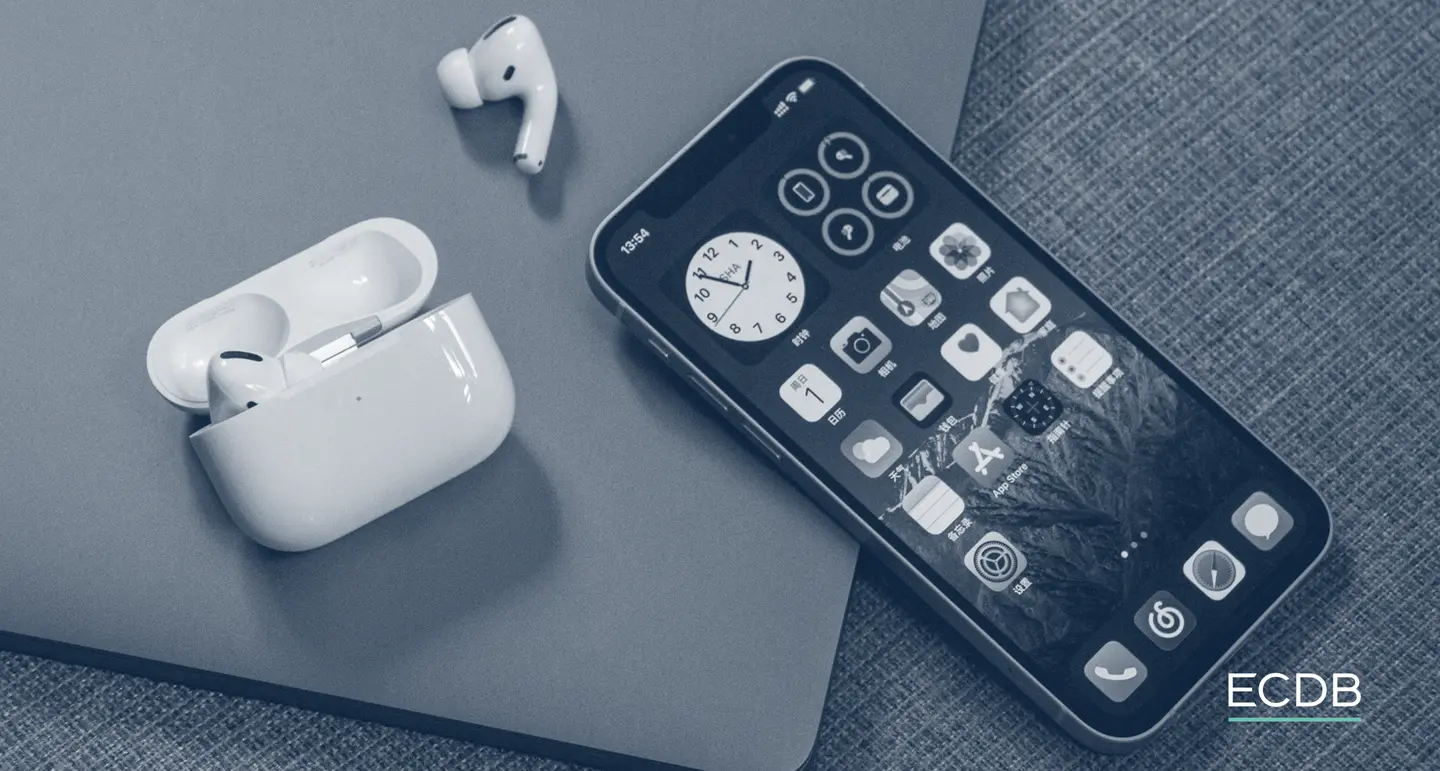
iPhone Sales Online: Key Insights
Global Market Leader: In 2023, Apple became the global leader in the smartphone market for the first time, achieving a 20% market share and generating over US$200 billion in revenue from iPhone sales.
Impact of New Releases: New iPhone releases, along with software upgrades, typically lead to spikes in online searches and eCommerce activity, but other factors like market conditions and consumer demand also play crucial roles in shipment volumes.
eCommerce Revenue: In 2023, Apple's eCommerce activities generated US$51 billion, with the United States leading at 55%, while eCommerce contributed 12% to Apple's total revenue, dominated by iPhone sales at US$200 billion.
Indirect Sales Channels: In 2023, only 37% of iPhones were sold directly by Apple, with the majority (63%) sold through indirect channels like third-party cellular networks, wholesalers, and resellers, which offer broader reach and more affordable options.
Who knew that an announcement made in January 2007 by a certain turtleneck wearing CEO would change the mobile phone market forever?
Since then, the iPhone has taken the world by storm and become an irreplaceable necessity for millions of people. Apple's "Wonderlust" event last September introduced the highly anticipated iPhone 15, new Apple Watches, and other significant updates. Apple's move to the USB-C port on iPhones has been influential in terms of consumer preferences and has set new standards for eCommerce retailers.
While it's common knowledge that the iPhone has been quite influential in setting the standard for smartphones in general, what exactly is Apple's position in the broader smartphone market?
Smartphone Market: Apple Had the Highest Share in 2023
In 2023, Apple achieved a significant milestone by becoming the global leader in the smartphone market for the first time. Apple secured a 20.1% share of all smartphone shipments, surpassing Samsung, which held a 19.4% market share.
With US$250 billion in revenues last year, online smartphone market is forecast to make up 50% of the total smartphones market soon (currently around 40%).
In the fourth quarter of 2023, Apple dominated the market, with iPhones accounting for 24.7% of all new smartphones sold. This surge in sales contributed to the iPhone generating over US$200 billion in revenue for Apple in the 2023 financial year.
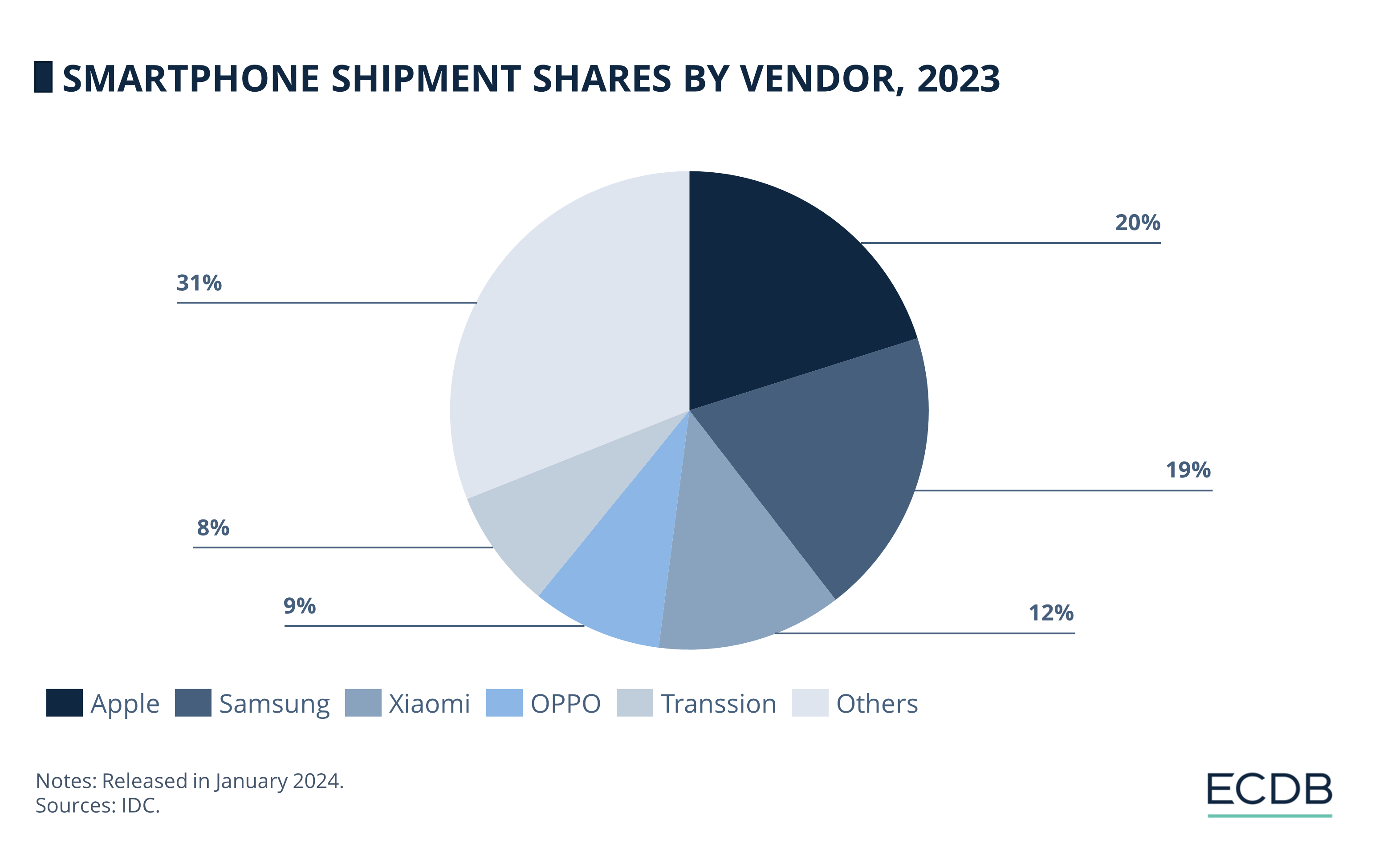
For Apple, the gradual increase in market share aligns with its product release cycles and improvements, although various factors could be influencing these shifts.
Do New iPhone Releases Bring More Sales?
In addition to hardware, software upgrades like iOS 17 and watchOS 10 were also rolled out with last year's release, which usually leads to a spike in online searches and eCommerce activity around Apple products.
While some of the data discussed in this article is sourced from offline metrics, it offers valuable insights into Apple's role as an eCommerce player. Analyzing offline commerce is essential for a comprehensive understanding of the eCommerce landscape, as it fills the gap in discussions often focused solely on online activities.
Looking at Apple's smartphone shipment data, we see the relationship between the company's annual product releases and their subsequent Q4 sales. Apple typically releases its flagship iPhone models in the September to October window, setting the stage for robust Q4 sales.
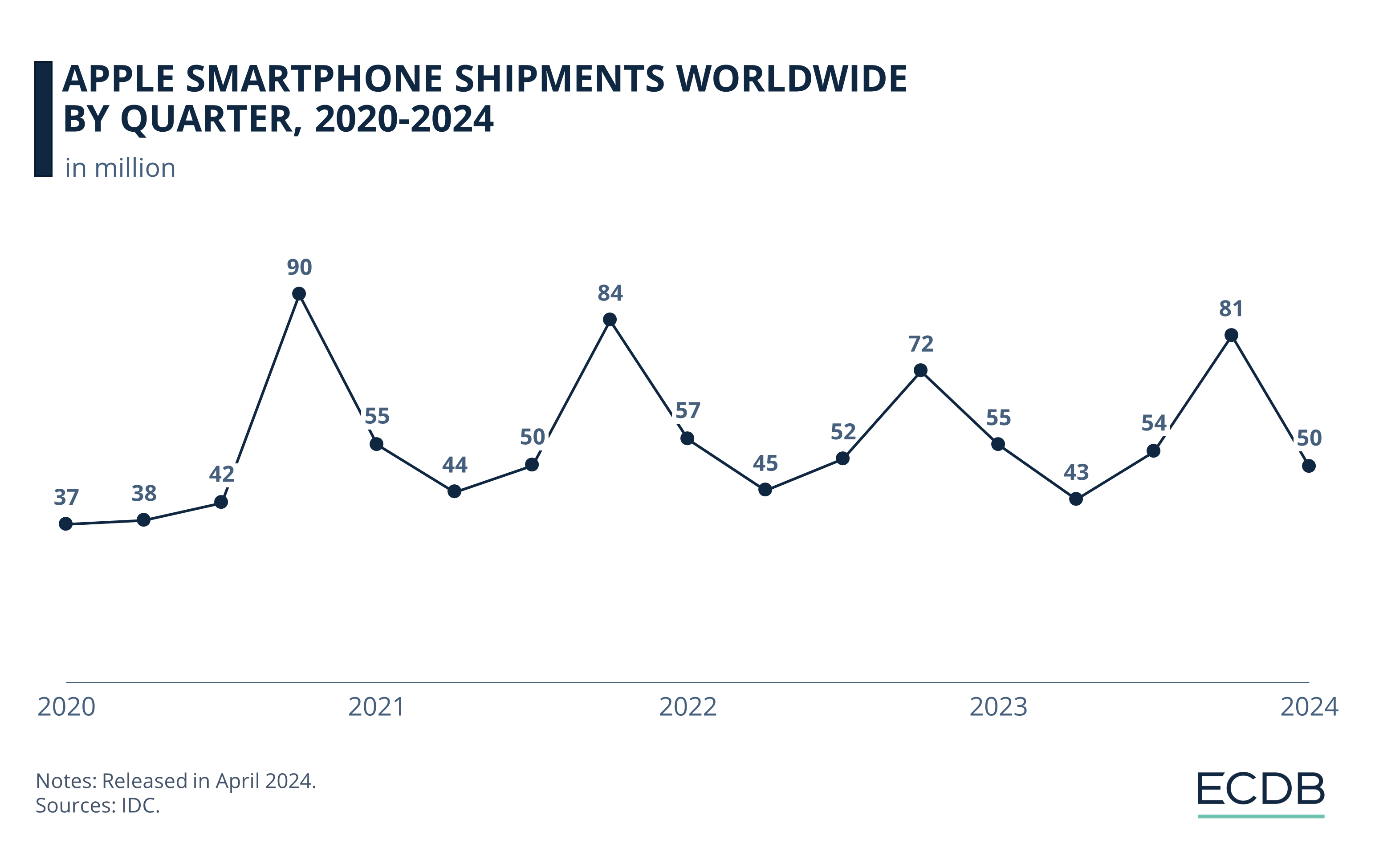
Apple's Q4 shipments have shown significant peaks over the years. In Q4 2020, Apple shipped 90.1 million units, driven by the release of the iPhone 12 and iPhone 12 Mini. Shipments in Q4 2021 were 84.1 million units, following the launch of the iPhone 13 series. In Q4 2022, shipments dropped to 72.3 million units despite the release of the iPhone 14 series.
However, in Q4 2023, shipments rebounded to 80.5 million units with the introduction of the iPhone 15. These fluctuations indicate that while new releases spur sales, other factors like market conditions and consumer demand also significantly impact shipment volumes.
For better context, let's also take a look at revenue figures.
Apple iPhone Revenue Growth
In the second quarter of its 2024 fiscal year, Apple generated around US$46 billion in revenue from iPhone sales, underscoring the device's importance to the company. Since its debut in 2007, the iPhone has sold over 1.5 billion units globally. By the first quarter of 2024, the iPhone held over 17% of the market share for new smartphone sales.
The iPhone's contribution to Apple's revenue has grown steadily. In the first quarter of 2009, iPhone sales accounted for about a quarter of Apple's revenue. By the second quarter of FY 2024, this figure had risen to roughly 50%, equating to over US$46 billion in that quarter alone.
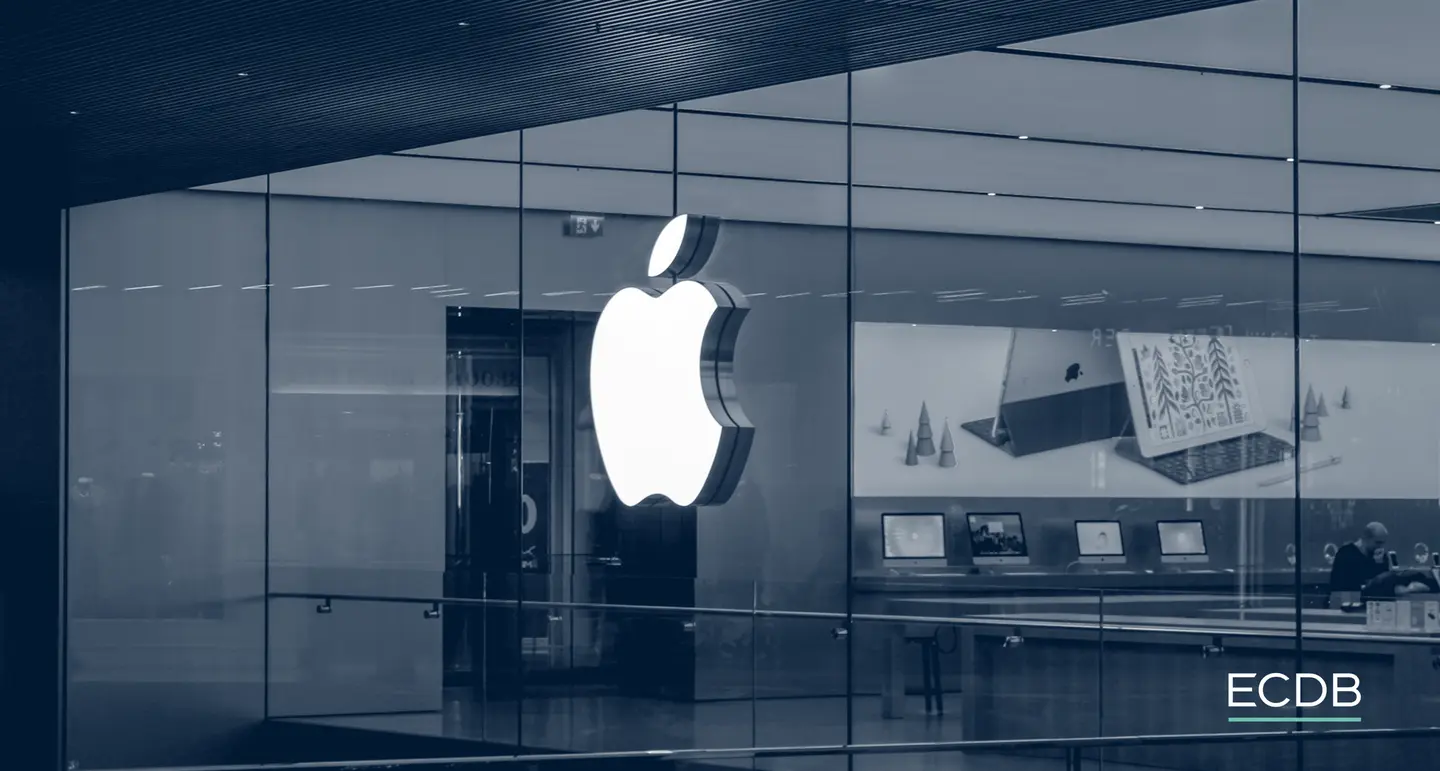
Apple Sales Online: Top Countries, Top Products & eCommerce Share
According to our data, Apple's eCommerce activities generated US$51.6 billion in 2023. Here's a peek at the top 5 countries with the highest share of Apple's eCommerce revenue:
United States: 54.8%
Japan: 6.4%
Greater China: 6.3%
United Kingdom: 4.9%
Canada: 3.9%
To put things in perspective, we have to ask: how much of Apple's total revenue comes from eCommerce anyway? Over the years, we observe fluctuating trends:
2019: 9.4%
2020: 10.6%
2021: 14.1%
2022: 14.3%
2023: 12.3%
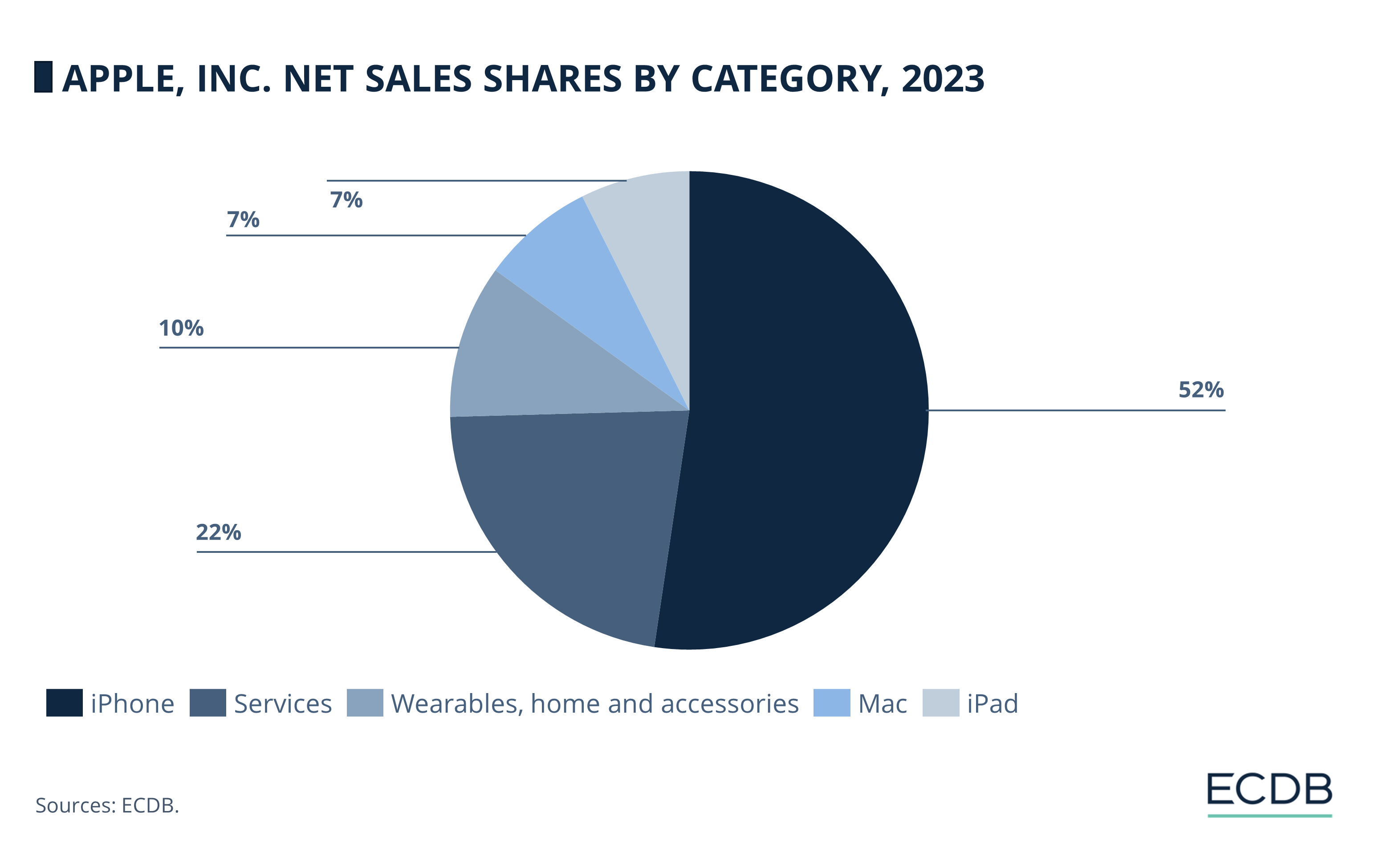
Not all Apple products are created equal, though. Apple's total revenue by category in 2023 highlights the dominance of the iPhone:
iPhone: US$200.6 billion (52%)
Services: US$85.2 billion (22%)
Wearables, home, and accessories: US$39.8 billion (10%)
Mac: US$29.4 billion (7%)
iPad: US$28.3 billion (7%)
But what share of iPhones are sold directly through Apple?
If you guess "most", you would be wrong.
Sales Channels of iPhones: Only One Third is Sold Directly by Apple
Apple’s approach to selling iPhones involves a strategic mix of indirect and direct channels, with a notable emphasis on the former. This strategy ensures maximum reach and accessibility, aligning with Apple's goal of making iPhones widely available.
iPhone Sales Through Indirect Channels
In 2023, 63% of Apple’s total sales came from indirect channels, including third-party cellular networks, wholesalers, retailers, and resellers. These channels help Apple reach a broader audience, distribute products more efficiently, and provide subsidies that make iPhones more affordable.
In the U.S., wireless carriers dominate iPhone sales due to their widespread store locations and established buying habits. Many consumers prefer the convenience and deals offered by carriers, such as free phones, over purchasing directly from Apple. This preference makes carriers the primary choice for iPhone upgrades.
Looking back at 2022, 62% of sales were through indirect channels, and in 2021, this figure was 64%, showing the consistent reliance on these partnerships. In the U.S. alone, 67% of recent iPhones were sold through wireless carriers, highlighting their dominant role in iPhone distribution.
iPhone Sales Through Direct Channels
The direct sales channel, which accounted for 37% of Apple's sales in 2023, mainly comprises Apple’s own retail stores. These stores offer a premium customer experience, facilitate various services including repairs and technical support, and reinforce the brand’s image.
In 2022 and 2021, direct channels represented 38% and 36% of sales, respectively. These stores are crucial for maintaining a direct connection with customers and ensuring they receive a high-quality experience that aligns with Apple’s brand.

iPhone Sales Online: Closing Thoughts
Apple's strategic blend of indirect and direct sales channels has been crucial in sustaining its robust market presence. By leveraging third-party networks, wholesalers, and its own retail stores, Apple achieves extensive market reach while maintaining a consistent brand experience. The increasing significance of online sales adds another layer to this strategy, meeting the modern consumer's demand for convenience and flexibility.
Offline data points provide a comprehensive understanding of Apple's retail strategy, highlighting the vital role they play in both online and brick-and-mortar sales. This balanced approach ensures that Apple remains at the forefront of the smartphone market, continuously adapting to and shaping consumer preferences.
Sources: YouTube, Apple, IDC, FourWeekMBA, The Verge, ECDB

Click here for
more relevant insights from
our partner Mastercard.
Related insights
Deep Dive
The Global B2B eCommerce Market: Why It Is Beneficial to Sell to Other Businesses
The Global B2B eCommerce Market: Why It Is Beneficial to Sell to Other Businesses
Deep Dive
Why Did Amazon Fail in China: Local Competition Defeats the Retail Giant
Why Did Amazon Fail in China: Local Competition Defeats the Retail Giant
Deep Dive
eCommerce in Indonesia: Revenues Projected to Cross US$100 Billion in 2025
eCommerce in Indonesia: Revenues Projected to Cross US$100 Billion in 2025
Deep Dive
Top 10 Online Shopping Sites in the USA: Amazon, Walmart, Apple
Top 10 Online Shopping Sites in the USA: Amazon, Walmart, Apple
Deep Dive
Online Ticketing 2024: Event Pricing, Market Size, & Trends
Online Ticketing 2024: Event Pricing, Market Size, & Trends
Back to main topics